Psychology Essay: Evaluating the Working Memory Model (2024)
VerifiedAdded on 2023/05/28
|8
|2957
|128
Essay
AI Summary
This essay provides a comprehensive overview of Baddeley and Hitch's working memory model, originally proposed in 1974 as an alternative to the short-term memory model. The essay begins by outlining the four key components of the working memory model: the central executive, phonological loop, visuo-spatial sketchpad, and episodic buffer. It then delves into the reasons why the original short-term memory model was deemed inadequate, primarily due to its limitations in explaining complex cognitive processes. The essay further examines the working memory model's superiority, supported by dual-task studies and research evidence, and discusses each component's functions and limitations. The central executive's role in attention and decision-making, the phonological loop's function in speech and sound processing, the visuo-spatial sketchpad's role in visual and spatial information, and the episodic buffer's integration of information from various sources are all explored. The essay concludes by highlighting the model's significance in understanding human cognitive abilities and its continuing development and influence in the field of psychology.
Contribute Materials
Your contribution can guide someone’s learning journey. Share your
documents today.

Running head: PSYCHOLOGY - WORKING MEMORY MODEL
PSYCHOLOGY - WORKING MEMORY MODEL
Name of the Student
Name of the University
Author Note
PSYCHOLOGY - WORKING MEMORY MODEL
Name of the Student
Name of the University
Author Note
Secure Best Marks with AI Grader
Need help grading? Try our AI Grader for instant feedback on your assignments.

1PSYCHOLOGY - WORKING MEMORY MODEL
The working memory model, proposed by Baddeley and Hitch in the year 1974 stated
that there are majorly four separate components that are compose the working memory of the
people concerned. The four major components of the model are central executive, phonological
loop, visuo-spatial scratch pad and episodic buffer (Baddeley, 2000). The short term memory
model is also referred to as the Atkinson and Shiffrin's 'multi-store' memory model. The model
suggested that the human memory had three distinct sections within itself, a long-term store, a
short-term store and the sensory register. The following paper takes an attempt at the outlining
of the working memory model as originally proposed by Baddeley and Hitch in the year 1974.
The essay attempts to throw further light on the issues that are presented by the authors that
rendered the earlier short term memory model inadequate. The paper then proceeds to discuss
the working memory model as a proper and satisfactory replacement for the short-term memory
model that was proposed earlier. The essay attempts to discuss the replacement in terms of the
researches that have been conducted in the previous years.
The working memory model that has been proposed by Baddeley and Hitch in the year
1974 was proposed to be an alternative for the existing model of the short-term memory. The
working memory model was majorly formulated on the basis of the findings that were derived
from the dual-task studies (Schulze et al., 2010). The model states that there are majorly four
separate components that are compose the working memory of the people concerned. The four
major components of the model are central executive, phonological loop, visuo-spatial scratch
pad and episodic buffer (Berry et al., 2018). The working memory is also known as the short
term memory of the person concerned and is responsible for the immediate awareness of the
concerned person. The short term memory can be distinguished well from the long term
memory of the person on the basis of the information that is contained within the given memory
strand. The term “working memory” is a refined term for the older concept of the short term
memory of the given person. The “short term memory” and the “working memory” are known to
have been synonymous terms and are at times used alternatively in the similar situations
(Gathercole & Baddeley, 2014). However, the term short term memory is generally known to
have been referring to the information storage of the humans while the term “working memory”
is used to deal with the storage of the information on the matters that deal with both the storage
as well as the manipulation of the information contained in the human mind at the given point of
time.
The first major component of the working memory model is the component of the central
executive. This component is helpful in the matters that are related to the areas of providing
The working memory model, proposed by Baddeley and Hitch in the year 1974 stated
that there are majorly four separate components that are compose the working memory of the
people concerned. The four major components of the model are central executive, phonological
loop, visuo-spatial scratch pad and episodic buffer (Baddeley, 2000). The short term memory
model is also referred to as the Atkinson and Shiffrin's 'multi-store' memory model. The model
suggested that the human memory had three distinct sections within itself, a long-term store, a
short-term store and the sensory register. The following paper takes an attempt at the outlining
of the working memory model as originally proposed by Baddeley and Hitch in the year 1974.
The essay attempts to throw further light on the issues that are presented by the authors that
rendered the earlier short term memory model inadequate. The paper then proceeds to discuss
the working memory model as a proper and satisfactory replacement for the short-term memory
model that was proposed earlier. The essay attempts to discuss the replacement in terms of the
researches that have been conducted in the previous years.
The working memory model that has been proposed by Baddeley and Hitch in the year
1974 was proposed to be an alternative for the existing model of the short-term memory. The
working memory model was majorly formulated on the basis of the findings that were derived
from the dual-task studies (Schulze et al., 2010). The model states that there are majorly four
separate components that are compose the working memory of the people concerned. The four
major components of the model are central executive, phonological loop, visuo-spatial scratch
pad and episodic buffer (Berry et al., 2018). The working memory is also known as the short
term memory of the person concerned and is responsible for the immediate awareness of the
concerned person. The short term memory can be distinguished well from the long term
memory of the person on the basis of the information that is contained within the given memory
strand. The term “working memory” is a refined term for the older concept of the short term
memory of the given person. The “short term memory” and the “working memory” are known to
have been synonymous terms and are at times used alternatively in the similar situations
(Gathercole & Baddeley, 2014). However, the term short term memory is generally known to
have been referring to the information storage of the humans while the term “working memory”
is used to deal with the storage of the information on the matters that deal with both the storage
as well as the manipulation of the information contained in the human mind at the given point of
time.
The first major component of the working memory model is the component of the central
executive. This component is helpful in the matters that are related to the areas of providing

2PSYCHOLOGY - WORKING MEMORY MODEL
proper solutions to the given problems as well as undertaking decisions in the given scenarios.
The central executive is known for the control over the attention that is invested by the
concerned person. The concerned component is known to have been playing a major role in the
matters that are related to the planning and the synthesizing of the information that are present
in the long term memory of the person and further considers the information that is required
from the subsidiary systems (Koopmann-Holm & O'Connor, 2017). The component of the
central executive is known to have been implementing the measures that are required for the
processing of the required information from various modalities and is known to have been
extremely flexible in operations. Allen, Baddeley and Hitch (2017) state that there is a limitation
on the storage capacity of the component thus it has led to the conditions wherein only a limited
amount of factors can be attended to in the given time.
The second factor that affects the working memory model refers to the phonological
loop. The working memory of the person is known to have been storing a stipulated number of
the phonological speech sounds and the other sounds that are attached to the speech activities
that are present within the given language (Baddeley, Hitch & Quinlan, 2018). The working
memory is known to have been composed of two different components majorly the process of
the articulation of the concerned speech sounds and the store of the phonological elements
within the given organization. The phonological storage allows the various items that were
coded in an acoustic manner to be stored for a short timespan (Hu et al., 2016). The process of
the articulation of the concerned speech sounds are also stored in the phonological loop with
the conditions that allow the repetition of the sounds in a sub-vocal area thereby facilitating the
proper articulation of the given speech sound.
The third factor affecting the working memory model refers to the visuo-spatial scratch
pad. This is helpful in the storage of the visual and the spatial information that is required for the
setting up as well as the manipulation of the mental images that are linked with the given
phonological articulation (Logie, 2014). This component is often compared to the inner eye of
the humans. The given component is composed of two different yet independent systems.
However, the systems within the component are known to have a limited amount of capacity.
The experts like Baddeley (2015) suggest that a person might be rehearsing a number of
factors in the phonological loop while at the same time he might be making decisions on the
matters that are related to the spatial layout of a completely different set of letters that are
present on the visual-spatial scratch pad.
proper solutions to the given problems as well as undertaking decisions in the given scenarios.
The central executive is known for the control over the attention that is invested by the
concerned person. The concerned component is known to have been playing a major role in the
matters that are related to the planning and the synthesizing of the information that are present
in the long term memory of the person and further considers the information that is required
from the subsidiary systems (Koopmann-Holm & O'Connor, 2017). The component of the
central executive is known to have been implementing the measures that are required for the
processing of the required information from various modalities and is known to have been
extremely flexible in operations. Allen, Baddeley and Hitch (2017) state that there is a limitation
on the storage capacity of the component thus it has led to the conditions wherein only a limited
amount of factors can be attended to in the given time.
The second factor that affects the working memory model refers to the phonological
loop. The working memory of the person is known to have been storing a stipulated number of
the phonological speech sounds and the other sounds that are attached to the speech activities
that are present within the given language (Baddeley, Hitch & Quinlan, 2018). The working
memory is known to have been composed of two different components majorly the process of
the articulation of the concerned speech sounds and the store of the phonological elements
within the given organization. The phonological storage allows the various items that were
coded in an acoustic manner to be stored for a short timespan (Hu et al., 2016). The process of
the articulation of the concerned speech sounds are also stored in the phonological loop with
the conditions that allow the repetition of the sounds in a sub-vocal area thereby facilitating the
proper articulation of the given speech sound.
The third factor affecting the working memory model refers to the visuo-spatial scratch
pad. This is helpful in the storage of the visual and the spatial information that is required for the
setting up as well as the manipulation of the mental images that are linked with the given
phonological articulation (Logie, 2014). This component is often compared to the inner eye of
the humans. The given component is composed of two different yet independent systems.
However, the systems within the component are known to have a limited amount of capacity.
The experts like Baddeley (2015) suggest that a person might be rehearsing a number of
factors in the phonological loop while at the same time he might be making decisions on the
matters that are related to the spatial layout of a completely different set of letters that are
present on the visual-spatial scratch pad.
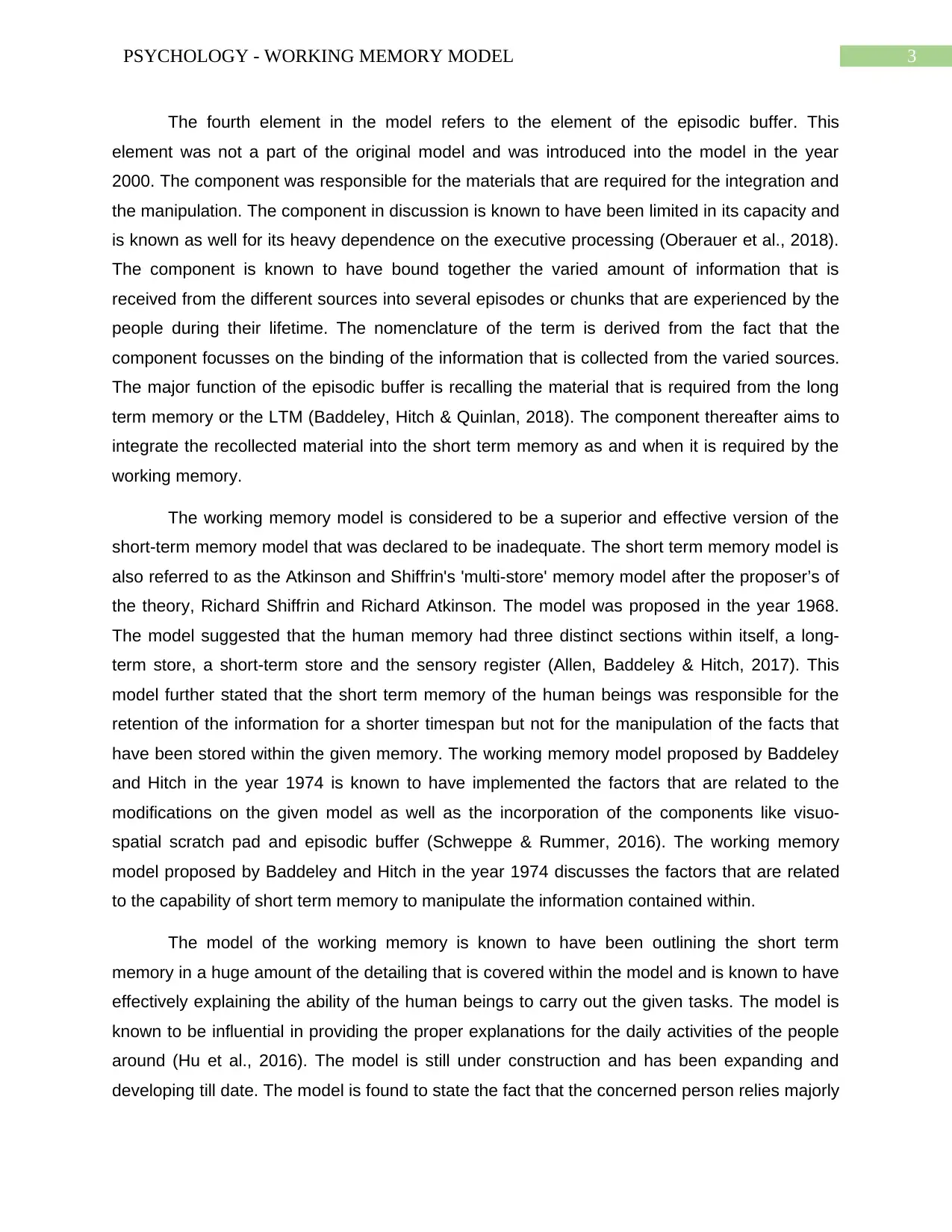
3PSYCHOLOGY - WORKING MEMORY MODEL
The fourth element in the model refers to the element of the episodic buffer. This
element was not a part of the original model and was introduced into the model in the year
2000. The component was responsible for the materials that are required for the integration and
the manipulation. The component in discussion is known to have been limited in its capacity and
is known as well for its heavy dependence on the executive processing (Oberauer et al., 2018).
The component is known to have bound together the varied amount of information that is
received from the different sources into several episodes or chunks that are experienced by the
people during their lifetime. The nomenclature of the term is derived from the fact that the
component focusses on the binding of the information that is collected from the varied sources.
The major function of the episodic buffer is recalling the material that is required from the long
term memory or the LTM (Baddeley, Hitch & Quinlan, 2018). The component thereafter aims to
integrate the recollected material into the short term memory as and when it is required by the
working memory.
The working memory model is considered to be a superior and effective version of the
short-term memory model that was declared to be inadequate. The short term memory model is
also referred to as the Atkinson and Shiffrin's 'multi-store' memory model after the proposer’s of
the theory, Richard Shiffrin and Richard Atkinson. The model was proposed in the year 1968.
The model suggested that the human memory had three distinct sections within itself, a long-
term store, a short-term store and the sensory register (Allen, Baddeley & Hitch, 2017). This
model further stated that the short term memory of the human beings was responsible for the
retention of the information for a shorter timespan but not for the manipulation of the facts that
have been stored within the given memory. The working memory model proposed by Baddeley
and Hitch in the year 1974 is known to have implemented the factors that are related to the
modifications on the given model as well as the incorporation of the components like visuo-
spatial scratch pad and episodic buffer (Schweppe & Rummer, 2016). The working memory
model proposed by Baddeley and Hitch in the year 1974 discusses the factors that are related
to the capability of short term memory to manipulate the information contained within.
The model of the working memory is known to have been outlining the short term
memory in a huge amount of the detailing that is covered within the model and is known to have
effectively explaining the ability of the human beings to carry out the given tasks. The model is
known to be influential in providing the proper explanations for the daily activities of the people
around (Hu et al., 2016). The model is still under construction and has been expanding and
developing till date. The model is found to state the fact that the concerned person relies majorly
The fourth element in the model refers to the element of the episodic buffer. This
element was not a part of the original model and was introduced into the model in the year
2000. The component was responsible for the materials that are required for the integration and
the manipulation. The component in discussion is known to have been limited in its capacity and
is known as well for its heavy dependence on the executive processing (Oberauer et al., 2018).
The component is known to have bound together the varied amount of information that is
received from the different sources into several episodes or chunks that are experienced by the
people during their lifetime. The nomenclature of the term is derived from the fact that the
component focusses on the binding of the information that is collected from the varied sources.
The major function of the episodic buffer is recalling the material that is required from the long
term memory or the LTM (Baddeley, Hitch & Quinlan, 2018). The component thereafter aims to
integrate the recollected material into the short term memory as and when it is required by the
working memory.
The working memory model is considered to be a superior and effective version of the
short-term memory model that was declared to be inadequate. The short term memory model is
also referred to as the Atkinson and Shiffrin's 'multi-store' memory model after the proposer’s of
the theory, Richard Shiffrin and Richard Atkinson. The model was proposed in the year 1968.
The model suggested that the human memory had three distinct sections within itself, a long-
term store, a short-term store and the sensory register (Allen, Baddeley & Hitch, 2017). This
model further stated that the short term memory of the human beings was responsible for the
retention of the information for a shorter timespan but not for the manipulation of the facts that
have been stored within the given memory. The working memory model proposed by Baddeley
and Hitch in the year 1974 is known to have implemented the factors that are related to the
modifications on the given model as well as the incorporation of the components like visuo-
spatial scratch pad and episodic buffer (Schweppe & Rummer, 2016). The working memory
model proposed by Baddeley and Hitch in the year 1974 discusses the factors that are related
to the capability of short term memory to manipulate the information contained within.
The model of the working memory is known to have been outlining the short term
memory in a huge amount of the detailing that is covered within the model and is known to have
effectively explaining the ability of the human beings to carry out the given tasks. The model is
known to be influential in providing the proper explanations for the daily activities of the people
around (Hu et al., 2016). The model is still under construction and has been expanding and
developing till date. The model is found to state the fact that the concerned person relies majorly
Secure Best Marks with AI Grader
Need help grading? Try our AI Grader for instant feedback on your assignments.
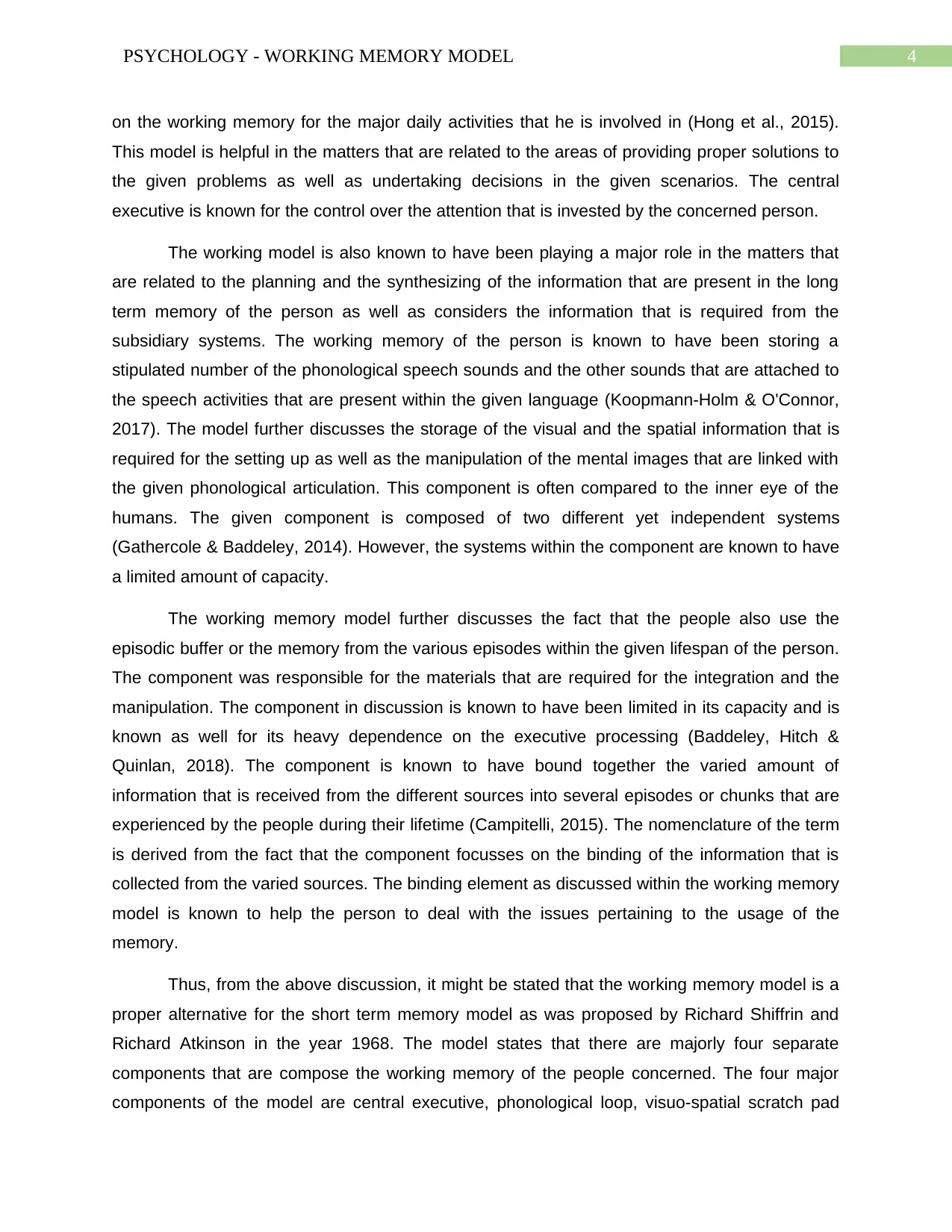
4PSYCHOLOGY - WORKING MEMORY MODEL
on the working memory for the major daily activities that he is involved in (Hong et al., 2015).
This model is helpful in the matters that are related to the areas of providing proper solutions to
the given problems as well as undertaking decisions in the given scenarios. The central
executive is known for the control over the attention that is invested by the concerned person.
The working model is also known to have been playing a major role in the matters that
are related to the planning and the synthesizing of the information that are present in the long
term memory of the person as well as considers the information that is required from the
subsidiary systems. The working memory of the person is known to have been storing a
stipulated number of the phonological speech sounds and the other sounds that are attached to
the speech activities that are present within the given language (Koopmann-Holm & O'Connor,
2017). The model further discusses the storage of the visual and the spatial information that is
required for the setting up as well as the manipulation of the mental images that are linked with
the given phonological articulation. This component is often compared to the inner eye of the
humans. The given component is composed of two different yet independent systems
(Gathercole & Baddeley, 2014). However, the systems within the component are known to have
a limited amount of capacity.
The working memory model further discusses the fact that the people also use the
episodic buffer or the memory from the various episodes within the given lifespan of the person.
The component was responsible for the materials that are required for the integration and the
manipulation. The component in discussion is known to have been limited in its capacity and is
known as well for its heavy dependence on the executive processing (Baddeley, Hitch &
Quinlan, 2018). The component is known to have bound together the varied amount of
information that is received from the different sources into several episodes or chunks that are
experienced by the people during their lifetime (Campitelli, 2015). The nomenclature of the term
is derived from the fact that the component focusses on the binding of the information that is
collected from the varied sources. The binding element as discussed within the working memory
model is known to help the person to deal with the issues pertaining to the usage of the
memory.
Thus, from the above discussion, it might be stated that the working memory model is a
proper alternative for the short term memory model as was proposed by Richard Shiffrin and
Richard Atkinson in the year 1968. The model states that there are majorly four separate
components that are compose the working memory of the people concerned. The four major
components of the model are central executive, phonological loop, visuo-spatial scratch pad
on the working memory for the major daily activities that he is involved in (Hong et al., 2015).
This model is helpful in the matters that are related to the areas of providing proper solutions to
the given problems as well as undertaking decisions in the given scenarios. The central
executive is known for the control over the attention that is invested by the concerned person.
The working model is also known to have been playing a major role in the matters that
are related to the planning and the synthesizing of the information that are present in the long
term memory of the person as well as considers the information that is required from the
subsidiary systems. The working memory of the person is known to have been storing a
stipulated number of the phonological speech sounds and the other sounds that are attached to
the speech activities that are present within the given language (Koopmann-Holm & O'Connor,
2017). The model further discusses the storage of the visual and the spatial information that is
required for the setting up as well as the manipulation of the mental images that are linked with
the given phonological articulation. This component is often compared to the inner eye of the
humans. The given component is composed of two different yet independent systems
(Gathercole & Baddeley, 2014). However, the systems within the component are known to have
a limited amount of capacity.
The working memory model further discusses the fact that the people also use the
episodic buffer or the memory from the various episodes within the given lifespan of the person.
The component was responsible for the materials that are required for the integration and the
manipulation. The component in discussion is known to have been limited in its capacity and is
known as well for its heavy dependence on the executive processing (Baddeley, Hitch &
Quinlan, 2018). The component is known to have bound together the varied amount of
information that is received from the different sources into several episodes or chunks that are
experienced by the people during their lifetime (Campitelli, 2015). The nomenclature of the term
is derived from the fact that the component focusses on the binding of the information that is
collected from the varied sources. The binding element as discussed within the working memory
model is known to help the person to deal with the issues pertaining to the usage of the
memory.
Thus, from the above discussion, it might be stated that the working memory model is a
proper alternative for the short term memory model as was proposed by Richard Shiffrin and
Richard Atkinson in the year 1968. The model states that there are majorly four separate
components that are compose the working memory of the people concerned. The four major
components of the model are central executive, phonological loop, visuo-spatial scratch pad
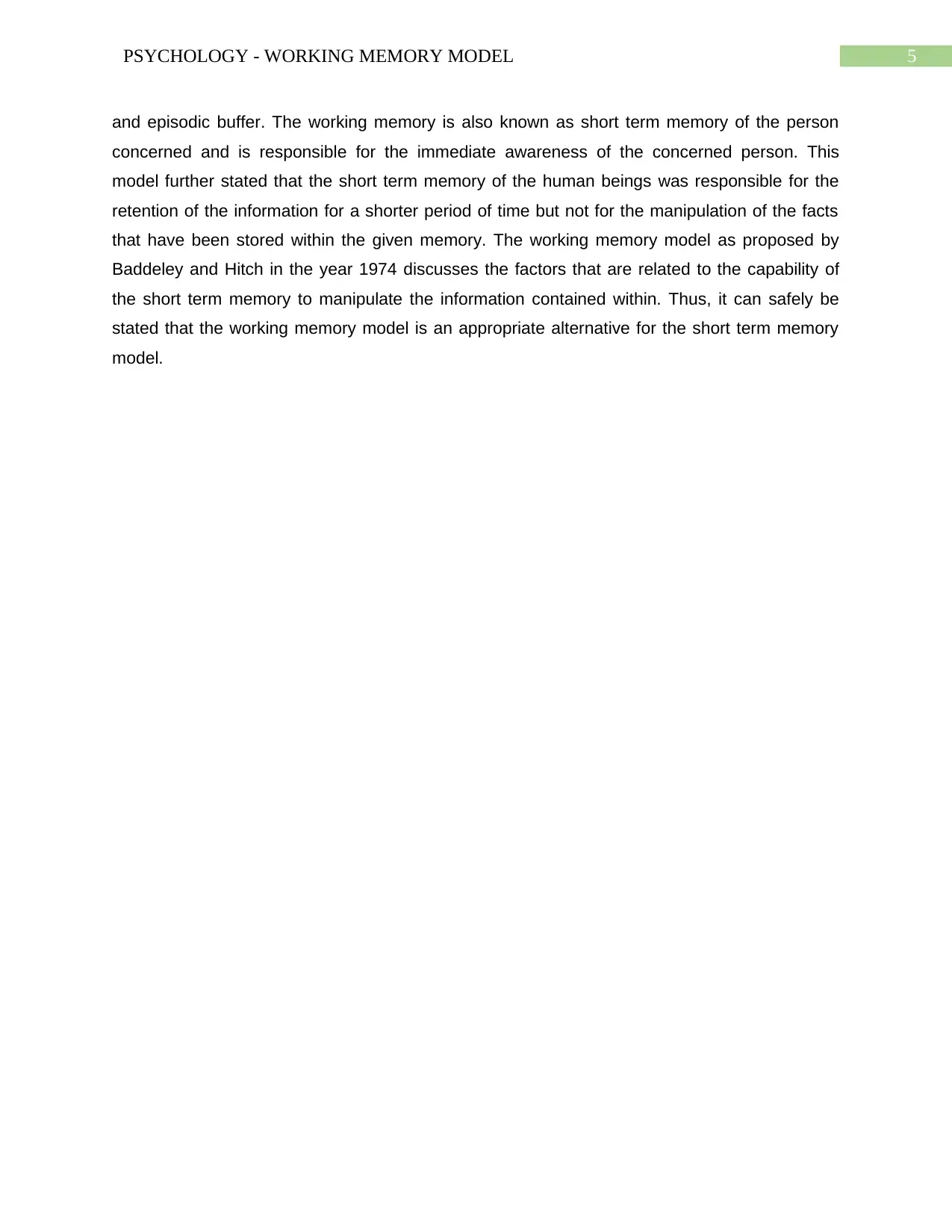
5PSYCHOLOGY - WORKING MEMORY MODEL
and episodic buffer. The working memory is also known as short term memory of the person
concerned and is responsible for the immediate awareness of the concerned person. This
model further stated that the short term memory of the human beings was responsible for the
retention of the information for a shorter period of time but not for the manipulation of the facts
that have been stored within the given memory. The working memory model as proposed by
Baddeley and Hitch in the year 1974 discusses the factors that are related to the capability of
the short term memory to manipulate the information contained within. Thus, it can safely be
stated that the working memory model is an appropriate alternative for the short term memory
model.
and episodic buffer. The working memory is also known as short term memory of the person
concerned and is responsible for the immediate awareness of the concerned person. This
model further stated that the short term memory of the human beings was responsible for the
retention of the information for a shorter period of time but not for the manipulation of the facts
that have been stored within the given memory. The working memory model as proposed by
Baddeley and Hitch in the year 1974 discusses the factors that are related to the capability of
the short term memory to manipulate the information contained within. Thus, it can safely be
stated that the working memory model is an appropriate alternative for the short term memory
model.
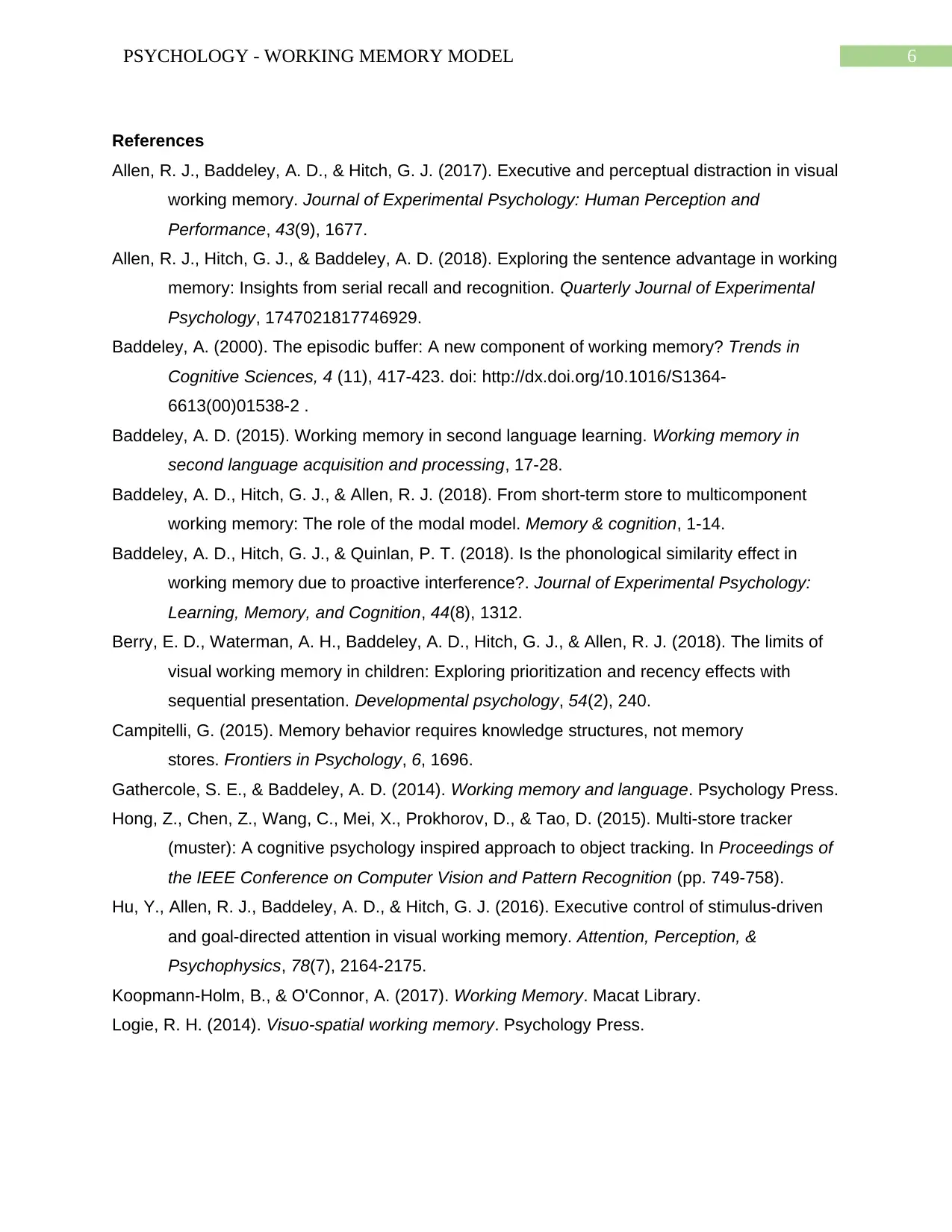
6PSYCHOLOGY - WORKING MEMORY MODEL
References
Allen, R. J., Baddeley, A. D., & Hitch, G. J. (2017). Executive and perceptual distraction in visual
working memory. Journal of Experimental Psychology: Human Perception and
Performance, 43(9), 1677.
Allen, R. J., Hitch, G. J., & Baddeley, A. D. (2018). Exploring the sentence advantage in working
memory: Insights from serial recall and recognition. Quarterly Journal of Experimental
Psychology, 1747021817746929.
Baddeley, A. (2000). The episodic buffer: A new component of working memory? Trends in
Cognitive Sciences, 4 (11), 417-423. doi: http://dx.doi.org/10.1016/S1364-
6613(00)01538-2 .
Baddeley, A. D. (2015). Working memory in second language learning. Working memory in
second language acquisition and processing, 17-28.
Baddeley, A. D., Hitch, G. J., & Allen, R. J. (2018). From short-term store to multicomponent
working memory: The role of the modal model. Memory & cognition, 1-14.
Baddeley, A. D., Hitch, G. J., & Quinlan, P. T. (2018). Is the phonological similarity effect in
working memory due to proactive interference?. Journal of Experimental Psychology:
Learning, Memory, and Cognition, 44(8), 1312.
Berry, E. D., Waterman, A. H., Baddeley, A. D., Hitch, G. J., & Allen, R. J. (2018). The limits of
visual working memory in children: Exploring prioritization and recency effects with
sequential presentation. Developmental psychology, 54(2), 240.
Campitelli, G. (2015). Memory behavior requires knowledge structures, not memory
stores. Frontiers in Psychology, 6, 1696.
Gathercole, S. E., & Baddeley, A. D. (2014). Working memory and language. Psychology Press.
Hong, Z., Chen, Z., Wang, C., Mei, X., Prokhorov, D., & Tao, D. (2015). Multi-store tracker
(muster): A cognitive psychology inspired approach to object tracking. In Proceedings of
the IEEE Conference on Computer Vision and Pattern Recognition (pp. 749-758).
Hu, Y., Allen, R. J., Baddeley, A. D., & Hitch, G. J. (2016). Executive control of stimulus-driven
and goal-directed attention in visual working memory. Attention, Perception, &
Psychophysics, 78(7), 2164-2175.
Koopmann-Holm, B., & O'Connor, A. (2017). Working Memory. Macat Library.
Logie, R. H. (2014). Visuo-spatial working memory. Psychology Press.
References
Allen, R. J., Baddeley, A. D., & Hitch, G. J. (2017). Executive and perceptual distraction in visual
working memory. Journal of Experimental Psychology: Human Perception and
Performance, 43(9), 1677.
Allen, R. J., Hitch, G. J., & Baddeley, A. D. (2018). Exploring the sentence advantage in working
memory: Insights from serial recall and recognition. Quarterly Journal of Experimental
Psychology, 1747021817746929.
Baddeley, A. (2000). The episodic buffer: A new component of working memory? Trends in
Cognitive Sciences, 4 (11), 417-423. doi: http://dx.doi.org/10.1016/S1364-
6613(00)01538-2 .
Baddeley, A. D. (2015). Working memory in second language learning. Working memory in
second language acquisition and processing, 17-28.
Baddeley, A. D., Hitch, G. J., & Allen, R. J. (2018). From short-term store to multicomponent
working memory: The role of the modal model. Memory & cognition, 1-14.
Baddeley, A. D., Hitch, G. J., & Quinlan, P. T. (2018). Is the phonological similarity effect in
working memory due to proactive interference?. Journal of Experimental Psychology:
Learning, Memory, and Cognition, 44(8), 1312.
Berry, E. D., Waterman, A. H., Baddeley, A. D., Hitch, G. J., & Allen, R. J. (2018). The limits of
visual working memory in children: Exploring prioritization and recency effects with
sequential presentation. Developmental psychology, 54(2), 240.
Campitelli, G. (2015). Memory behavior requires knowledge structures, not memory
stores. Frontiers in Psychology, 6, 1696.
Gathercole, S. E., & Baddeley, A. D. (2014). Working memory and language. Psychology Press.
Hong, Z., Chen, Z., Wang, C., Mei, X., Prokhorov, D., & Tao, D. (2015). Multi-store tracker
(muster): A cognitive psychology inspired approach to object tracking. In Proceedings of
the IEEE Conference on Computer Vision and Pattern Recognition (pp. 749-758).
Hu, Y., Allen, R. J., Baddeley, A. D., & Hitch, G. J. (2016). Executive control of stimulus-driven
and goal-directed attention in visual working memory. Attention, Perception, &
Psychophysics, 78(7), 2164-2175.
Koopmann-Holm, B., & O'Connor, A. (2017). Working Memory. Macat Library.
Logie, R. H. (2014). Visuo-spatial working memory. Psychology Press.
Paraphrase This Document
Need a fresh take? Get an instant paraphrase of this document with our AI Paraphraser
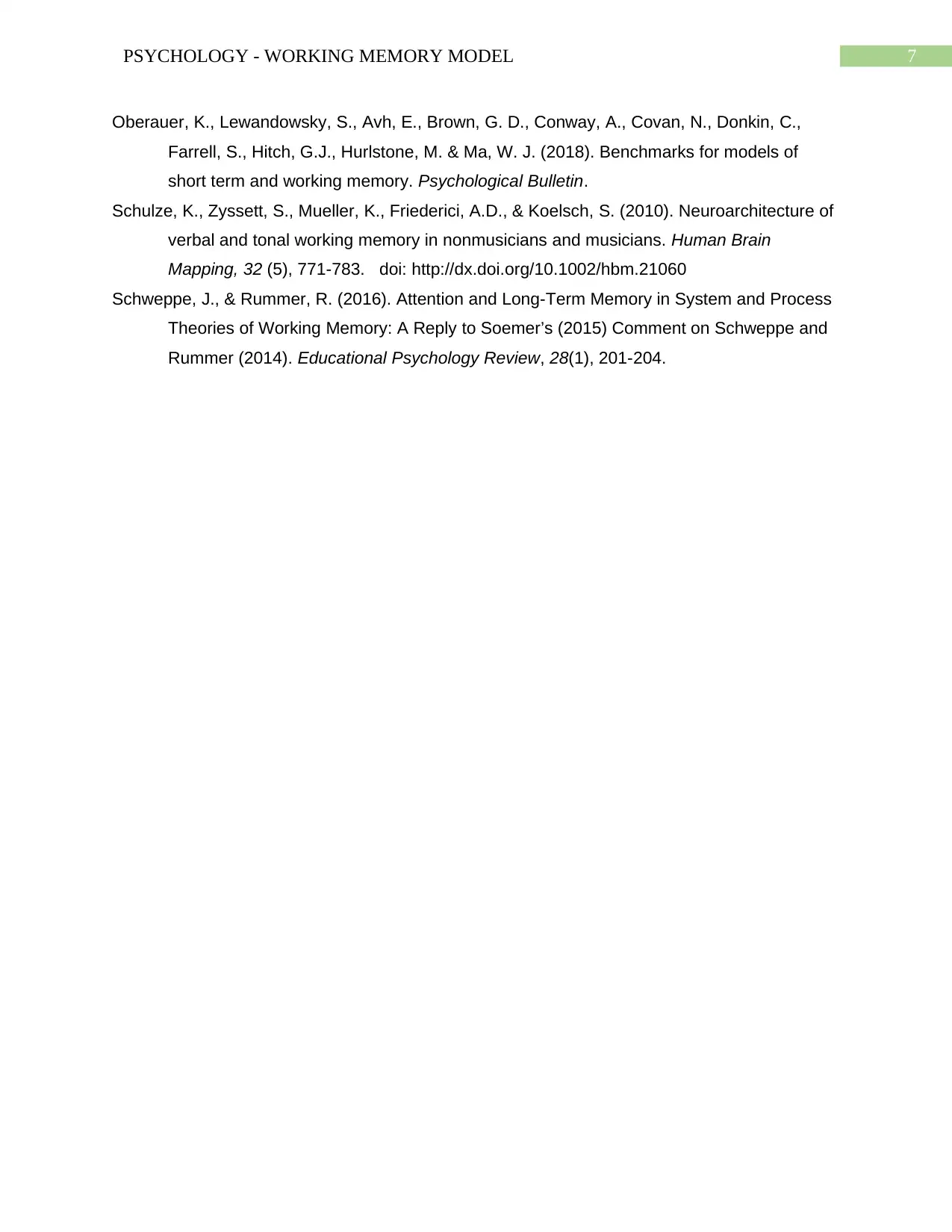
7PSYCHOLOGY - WORKING MEMORY MODEL
Oberauer, K., Lewandowsky, S., Avh, E., Brown, G. D., Conway, A., Covan, N., Donkin, C.,
Farrell, S., Hitch, G.J., Hurlstone, M. & Ma, W. J. (2018). Benchmarks for models of
short term and working memory. Psychological Bulletin.
Schulze, K., Zyssett, S., Mueller, K., Friederici, A.D., & Koelsch, S. (2010). Neuroarchitecture of
verbal and tonal working memory in nonmusicians and musicians. Human Brain
Mapping, 32 (5), 771-783. doi: http://dx.doi.org/10.1002/hbm.21060
Schweppe, J., & Rummer, R. (2016). Attention and Long-Term Memory in System and Process
Theories of Working Memory: A Reply to Soemer’s (2015) Comment on Schweppe and
Rummer (2014). Educational Psychology Review, 28(1), 201-204.
Oberauer, K., Lewandowsky, S., Avh, E., Brown, G. D., Conway, A., Covan, N., Donkin, C.,
Farrell, S., Hitch, G.J., Hurlstone, M. & Ma, W. J. (2018). Benchmarks for models of
short term and working memory. Psychological Bulletin.
Schulze, K., Zyssett, S., Mueller, K., Friederici, A.D., & Koelsch, S. (2010). Neuroarchitecture of
verbal and tonal working memory in nonmusicians and musicians. Human Brain
Mapping, 32 (5), 771-783. doi: http://dx.doi.org/10.1002/hbm.21060
Schweppe, J., & Rummer, R. (2016). Attention and Long-Term Memory in System and Process
Theories of Working Memory: A Reply to Soemer’s (2015) Comment on Schweppe and
Rummer (2014). Educational Psychology Review, 28(1), 201-204.
1 out of 8
Related Documents
Your All-in-One AI-Powered Toolkit for Academic Success.
+13062052269
info@desklib.com
Available 24*7 on WhatsApp / Email
![[object Object]](/_next/static/media/star-bottom.7253800d.svg)
Unlock your academic potential
© 2024 | Zucol Services PVT LTD | All rights reserved.





